Briefly: In our opinion, short (full) speculative positions in gold, silver and mining stocks are justified from the risk/reward point of view.
Gold, silver and mining stocks declined visibly yesterday and the volume on which this decline materialized was significant. Is this really a strong bearish signal, or is it just a temporary pullback?
We think the former is the case. There had been multiple bearish signals in the previous days and we just saw their short-term confirmations. The outlook was bearish and it’s even more bearish at this time. Let’s take a look at the charts (charts courtesy of http://stockcharts.com).
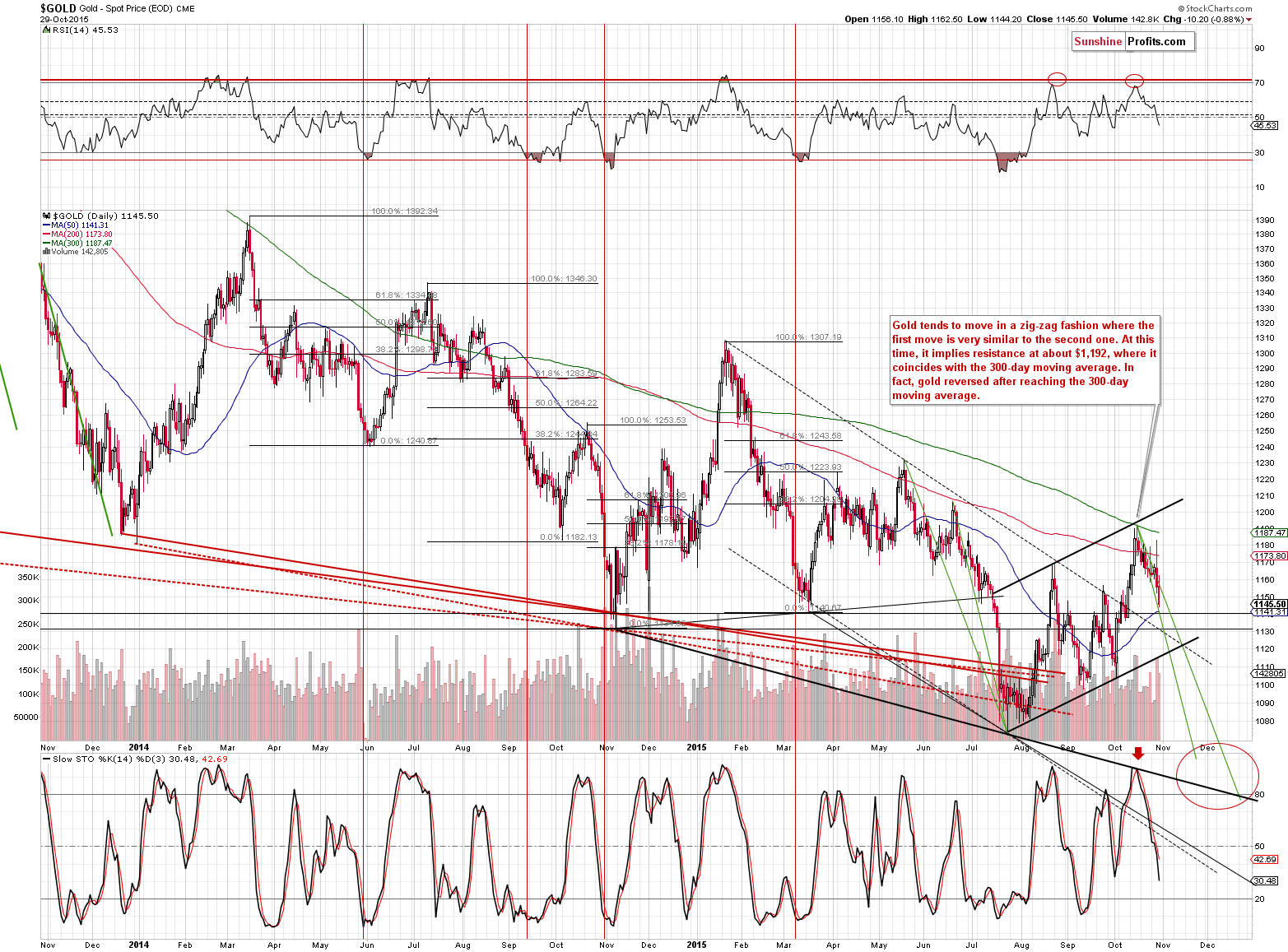
Gold declined substantially yesterday and once again it did so on significant volume. The decline is likely underway and it’s likely that the corrective upswing is already over. The trend remains down.
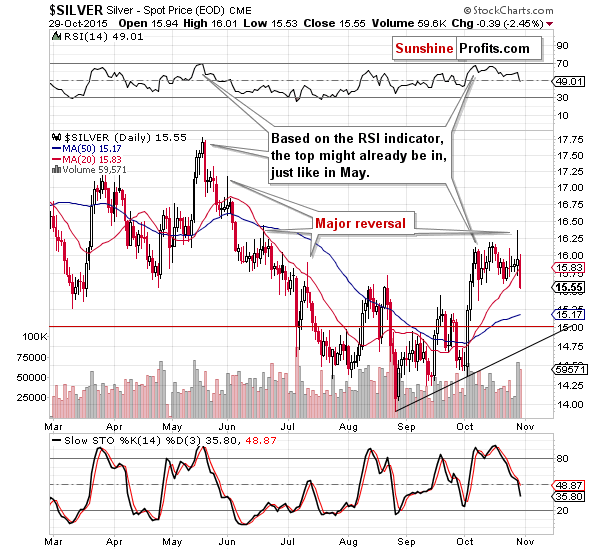
In yesterday’s alert, we commented on the above silver chart in the following way:
The interesting thing is that silver formed a daily reversal on huge volume. That’s a clear bearish sign for the short term – a one that we saw at previous local tops. Moreover, please note that on an intra-day basis, silver greatly outperformed gold, which is another bearish sign (such short-term outperformance periods very often preceded declines).
Silver declined on big volume yesterday, so the above was just confirmed. The outlook is clearly bearish as silver closed at the lowest levels since early October.
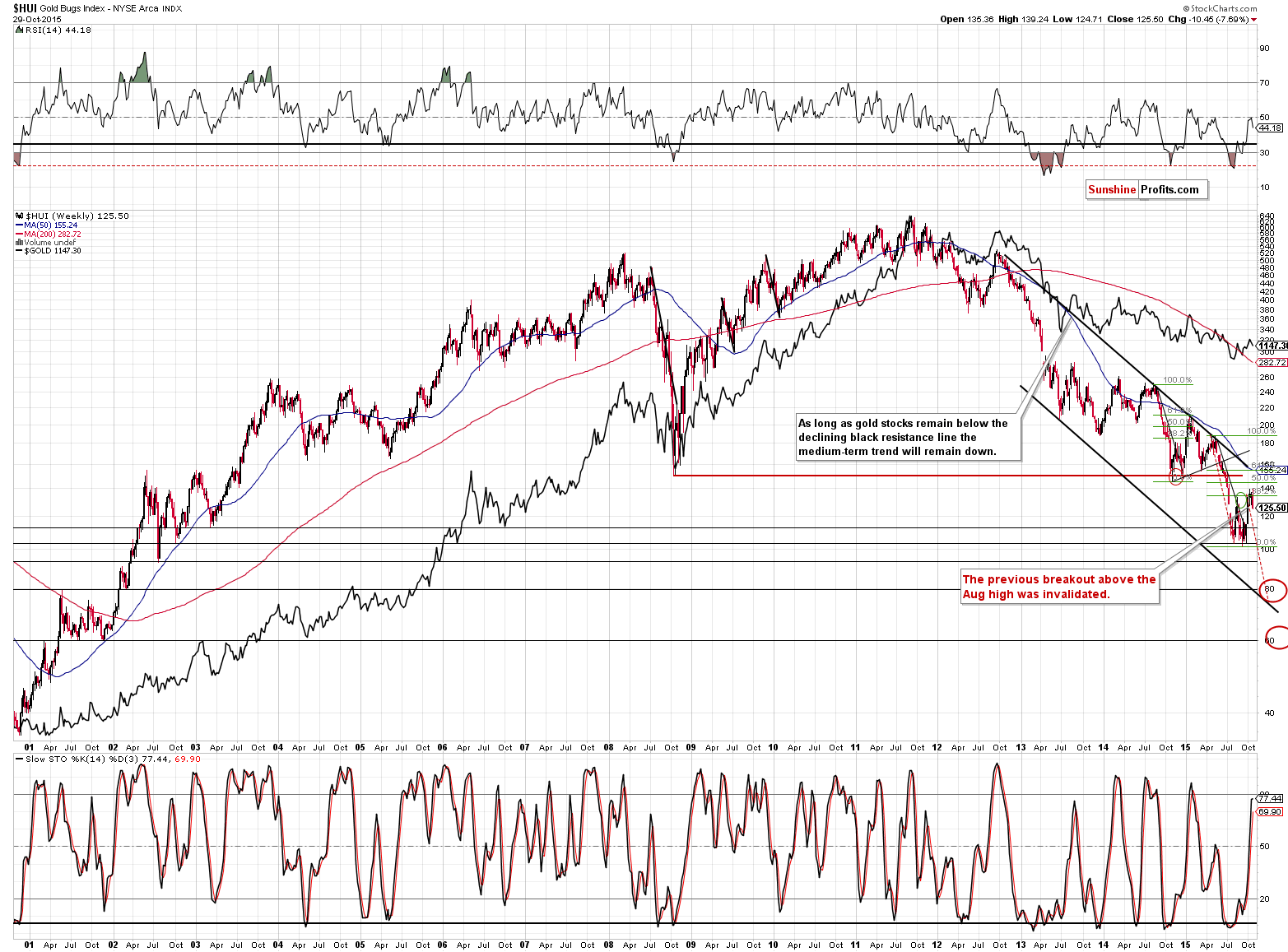
In yesterday’s alert, we wrote the following:
Gold stocks have moved lower this week and the breakout above the August high was once again invalidated. More importantly, please note that the Stochastic indicator moved above the 80 line. Each time (!) after 2011 (and many times before 2011) this (the sell signal served as a confirmation) meant that the local top was in or very close to being in and that short positions, not long ones, should’ve been strongly considered.
The Stochastic indicator moved lower, but the bearish implications remain in place. It’s likely that the next big move lower is already underway. The self-similar pattern confirms this outlook as well.
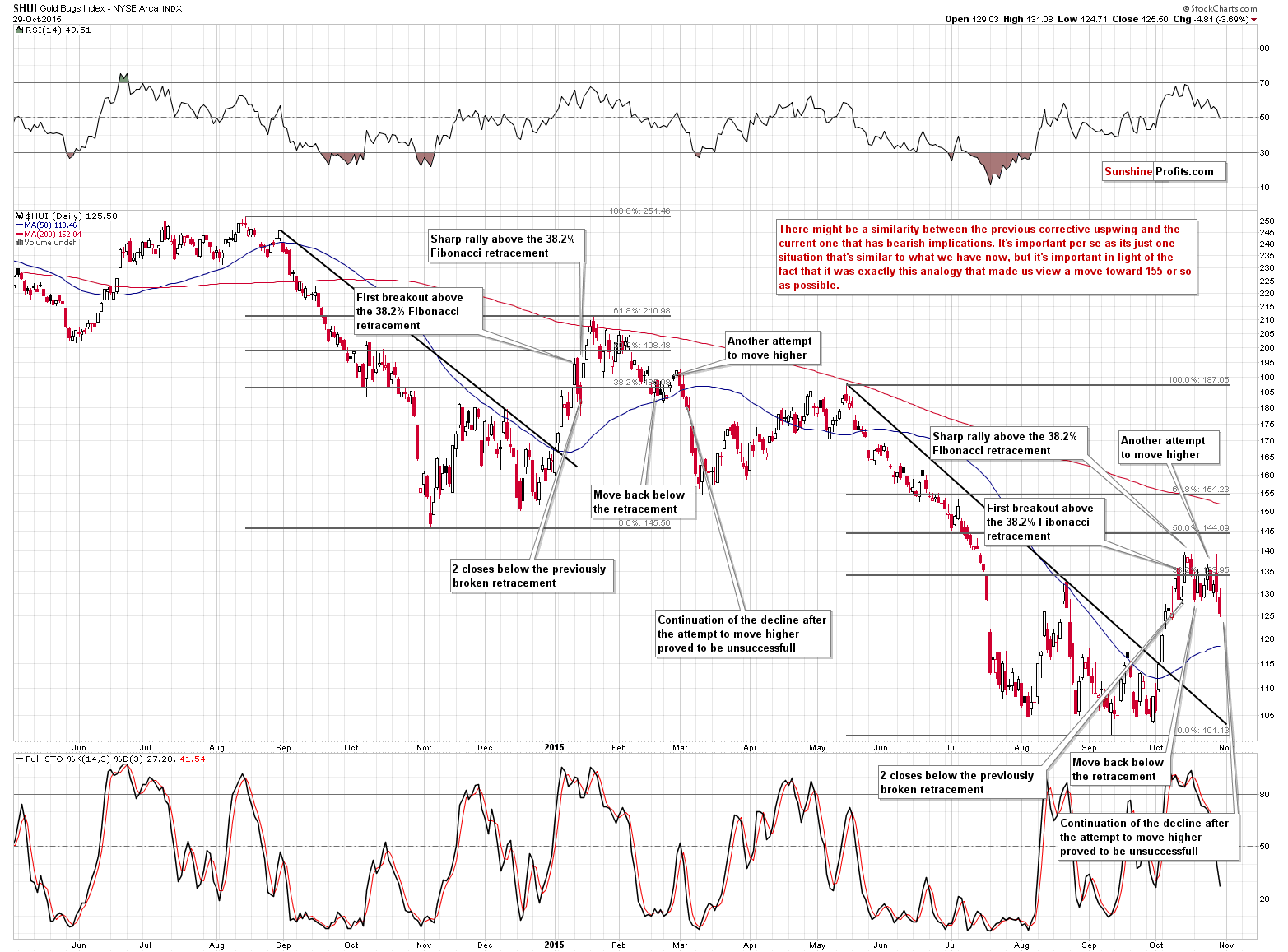
We recently wrote that the situation in the HUI Index was similar to what we had seen at and after the previous corrective upswing. As you can see on the above chart, this continues to be the case also today. This time we see gold stocks decisively moving below the August high and the recent lows. The implications are bearish.
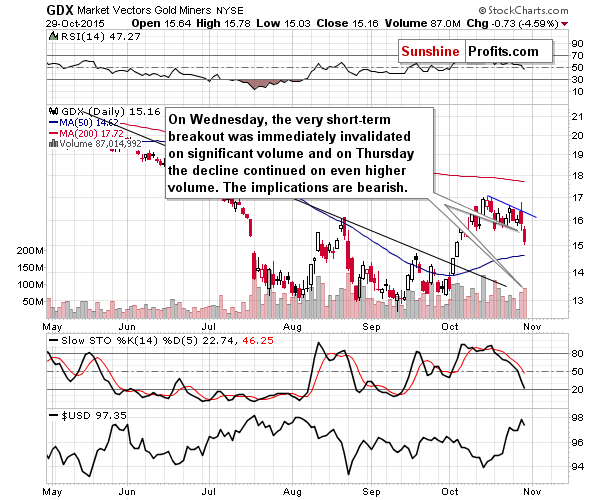
On the short-term GDX ETF chart, we see that the invalidation of the breakout resulted in another decline, as expected. Moreover, we see that the volume on which miners declined increased along with the decrease in price, which is a very bearish sign.
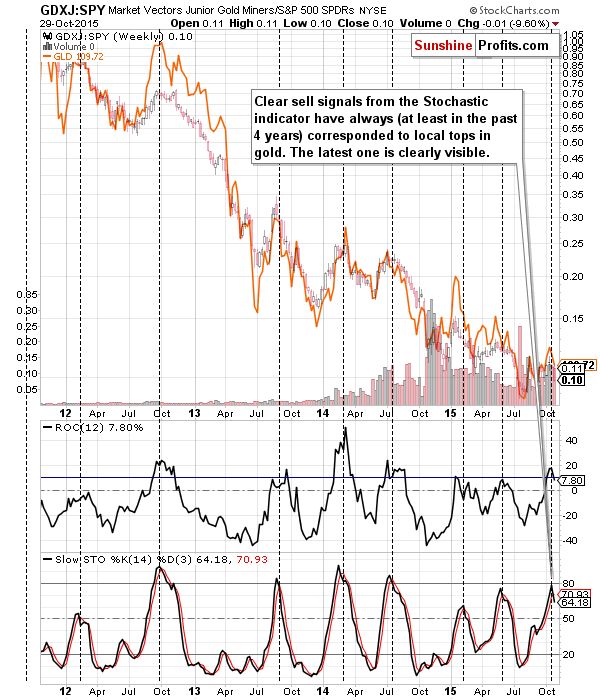
Finally, we are very likely seeing another major sell sign from the GDXJ to SPY ratio (performance of junior mining stocks relative to other stocks). Precisely, we see the sell signal based on what’s going on with the Stochastic and ROC indicators. Similar situations in the past meant that we were already after a major top. This fits well with other signals that we’ve been discussing recently.
Summing up, the decline in the precious metals sector continues and it does so on strong volume, which makes the bearish outlook even more bearish. It seems that the corrective upswing is already over. Most importantly, multiple bearish signals that we’ve described in the recent alerts remain in place and continue to have very bearish implications for the medium term. It seems that the next big move will be to the downside and being positioned to take advantage of it remains justified from the risk/reward point of view. It seems likely that the current short position will further increase our profitability.
As always, we will keep you – our subscribers – updated.
To summarize:
Trading capital (our opinion): Short position (full) position in gold, silver and mining stocks is justified from the risk/reward perspective with the following stop-loss orders and initial (! – this means that reaching them doesn’t automatically close the position) target prices:
- Gold: initial target price: $1,050; stop-loss: $1,223, initial target price for the DGLD ETN: $98.37; stop loss for the DGLD ETN $62.34
- Silver: initial target price: $12.60; stop-loss: $16.73, initial target price for the DSLV ETN: $96.67; stop loss for DSLV ETN $40.28
- Mining stocks (price levels for the GDX ETF): initial target price: $11.57; stop-loss: $18.13, initial target price for the DUST ETF: $26.61; stop loss for the DUST ETF $9.22
In case one wants to bet on junior mining stocks' prices (we do not suggest doing so – we think senior mining stocks are more predictable in the case of short-term trades – if one wants to do it anyway, we provide the details), here are the stop-loss details and initial target prices:
- GDXJ ETF: initial target price: $16.27; stop-loss: $25.23
- JDST ETF: initial target price: $46.47; stop-loss: $15.58
Long-term capital (our opinion): No positions
Insurance capital (our opinion): Full position
Please note that a full position doesn’t mean using all of the capital for a given trade. You will find details on our thoughts on gold portfolio structuring in the Key Insights section on our website.
As a reminder – “initial target price” means exactly that – an “initial” one, it’s not a price level at which we suggest closing positions. If this becomes the case (like it did in the previous trade) we will refer to these levels as levels of exit orders (exactly as we’ve done previously). Stop-loss levels, however, are naturally not “initial”, but something that, in our opinion, might be entered as an order.
Since it is impossible to synchronize target prices and stop-loss levels for all the ETFs and ETNs with the main markets that we provide these levels for (gold, silver and mining stocks – the GDX ETF), the stop-loss levels and target prices for other ETNs and ETF (among other: UGLD, DGLD, USLV, DSLV, NUGT, DUST, JNUG, JDST) are provided as supplementary, and not as “final”. This means that if a stop-loss or a target level is reached for any of the “additional instruments” (DGLD for instance), but not for the “main instrument” (gold in this case), we will view positions in both gold and DGLD as still open and the stop-loss for DGLD would have to be moved lower. On the other hand, if gold moves to a stop-loss level but DGLD doesn’t, then we will view both positions (in gold and DGLD) as closed. In other words, since it’s not possible to be 100% certain that each related instrument moves to a given level when the underlying instrument does, we can’t provide levels that would be binding. The levels that we do provide are our best estimate of the levels that will correspond to the levels in the underlying assets, but it will be the underlying assets that one will need to focus on regarding the sings pointing to closing a given position or keeping it open. We might adjust the levels in the “additional instruments” without adjusting the levels in the “main instruments”, which will simply mean that we have improved our estimation of these levels, not that we changed our outlook on the markets. We are already working on a tool that would update these levels on a daily basis for the most popular ETFs, ETNs and individual mining stocks.
Our preferred ways to invest in and to trade gold along with the reasoning can be found in the how to buy gold section. Additionally, our preferred ETFs and ETNs can be found in our Gold & Silver ETF Ranking.
As always, we'll keep you - our subscribers - updated should our views on the market change. We will continue to send out Gold & Silver Trading Alerts on each trading day and we will send additional Alerts whenever appropriate.
The trading position presented above is the netted version of positions based on subjective signals (opinion) from your Editor, and the Tools and Indicators.
As a reminder, Gold & Silver Trading Alerts are posted before or on each trading day (we usually post them before the opening bell, but we don't promise doing that each day). If there's anything urgent, we will send you an additional small alert before posting the main one.
=====
Latest Free Trading Alerts:
American gross domestic product rose at an annual rate of 1.5 percent in the third quarter. What does it imply for the U.S. economy and the gold market?
U.S. Economic Growth Slows to 1.5%
=====
Hand-picked precious-metals-related links:
Interview: Ross Strachan from GFMS on the outlook for gold
Barrick Stays Bullish as Gold Prices Head for Third Annual Drop
Gold monetisation scheme: Collective effort needed to unlock 20,000 tonnes of precious metal
Goldcorp shares are being decimated
Liquidation time for Venezuela (and its gold)
=====
In other news:
Obama wins debt-limit, budget truce through end of presidency
Yuan Rises Most Since 2005 as PBOC Mulls Easing Capital Controls
China wants to double its economy by 2020
=====
Thank you.
Sincerely,
Przemyslaw Radomski, CFA
Founder, Editor-in-chief
Gold & Silver Trading Alerts
Forex Trading Alerts
Oil Investment Updates
Oil Trading Alerts



